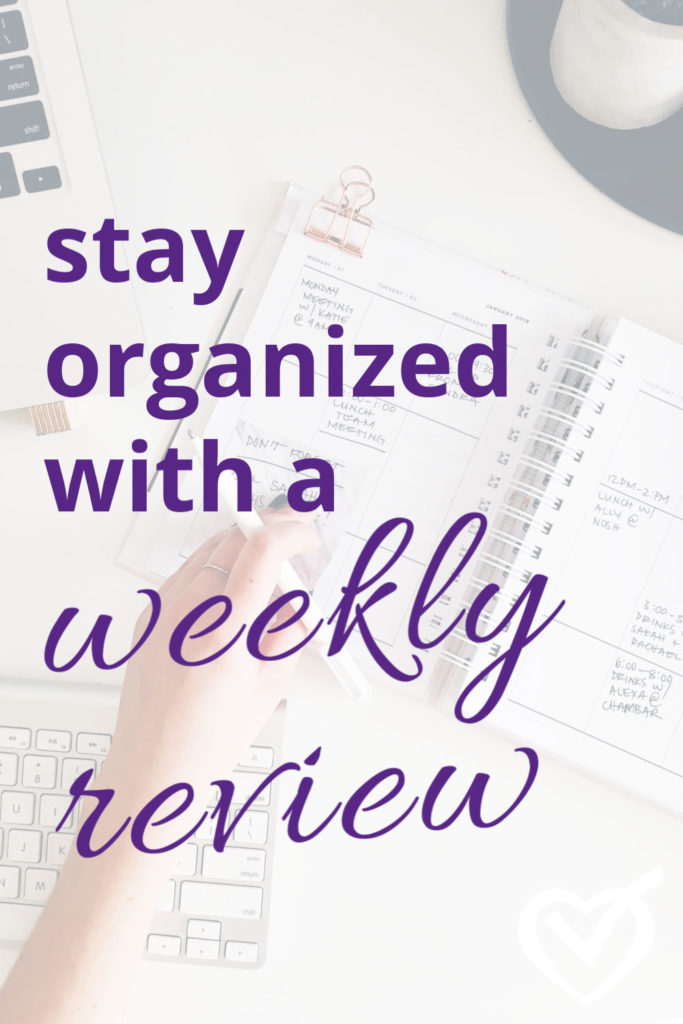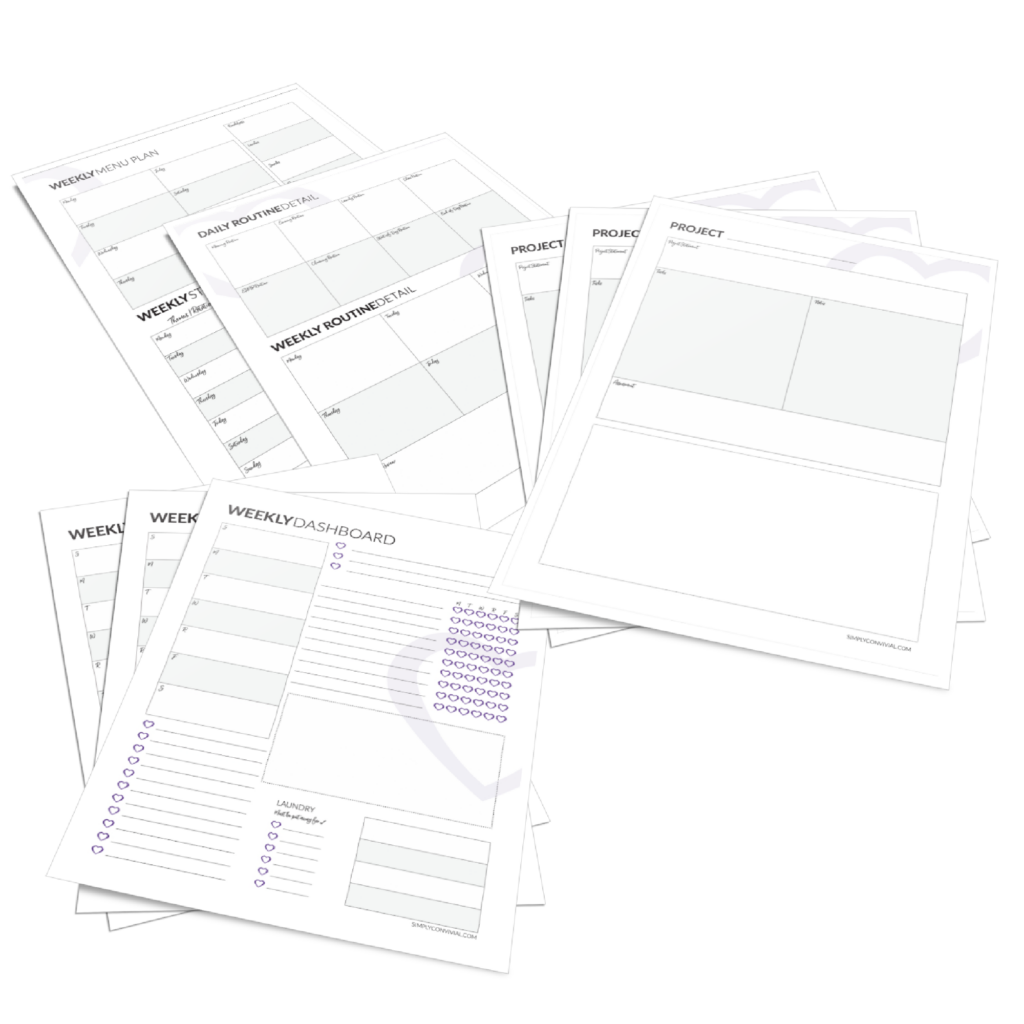
The weekly review is a time set aside to remind yourself to what you have on your plate and choose your commitments so you can stay organized.
You take some time and look at your calendar, make fresh to-do lists, decide what your biggest responsibilities are this week and then make sure those stay in front of your face so they can get done.
Once we spend some time getting organized, the next step is to stay organized. We can’t stay organized without looking at our plans and keeping our systems on track. A weekly review is my top tip for how to organize your life.
Moms need a weekly review just as much as a business executive. We have sports practices, volunteer dates, meals, and so much more we must accomplish in a week. The process of evaluating everything that’s upcoming in a calm manner beforehand helps us meet our commitments with peace and preparedness.

What is a weekly review for moms?
Regular review is the absolute key to maintaining a sense of organization. You have to look at your lists to make them happen, and that looking over is called a review.
A weekly review is my secret weapon to stay organized. It’s a time reserved for big picture thinking, planning, and list making. More importantly, it’s a time to LOOK at those lists – and my calendar.
The weekly review will sharpen your intuitive focus on your important projects as you deal with the flood of new input and potential distractions coming at you the rest of the week.
If you have a sense of where you are and where you’re going and what you have going on, you’ll be able to make better on-the-spot decisions about commitments and responsibilities and ideas that come at you throughout the week. That’s how to stay organized.
“The real trick to ensuring the trustworthiness of the whole organization system lies in regularly refreshing your psyche and your system from a more elevated perspective.”
David Allen, Getting Things Done
This review process is common sense, but few of us do it as well as we could, and that means as regularly as we [need to, in order] to keep a clear mind and a sense of relaxed control.
So, here’s what Getting Things Done says you should go through weekly:
- Gather all loose papers and stick them in your inbox.
- Process your inbox & any notes; review any journal or calendar entries.
- Enter any actions, events, ideas, or projects culled from inbox or a review of your notes & calendars into the appropriate lists.
- Look through your read/review pile — cull and reorder.
- Review your calendar, both previous and upcoming.
- Evaluate the status of all your projects, renewing as needed. New actions to your lists? Move some back to “someday”?
- Renew your next actions list — is it current and up to date?
- Review checklists — have you been forgetting anything?
- Glance through your someday/maybe lists for inspiration, activation, and deletion.
But it is hard to discipline ourselves to set aside the time. It’s more likely that we just keep on going as we’ve been going without pausing to reflect and set ourselves up for a solid, focused week. But it is only our own peace of mind and sanity we are sacrificing when we skip a weekly review.
How long does a weekly review take?
In his landmark book, Getting Things Done, David Allen says that a weekly review is the key to both peace of mind and staying organized. Allen recommends we set aside 2 hours at the end of every week to update your lists, do a brain-dump and processing routine, and generally evaluate how things went and what needs to be done next week. This is a time to look at your past calendar, transfer anything you need, look at what’s coming up for the next week and the next month, jot down any notes the overview inspires.
Instantly, the mom-mind rebels. We do not have a spare 2 hours each week! Allen tries to tell us we will reclaim wasted time by reserving a consistent regular review, and he’s not wrong, yet we still cannot commit 2 hours of uninterrupted time to anything as moms at home. There is no door to close.
However, a weekly review does not need to take two hours to be effective. In fact, a weekly review does not need to take an hour. You can take 15 minutes to get your stuff ready for the week ahead. A weekly review is the key, the linchpin, to all other plans, all other planners, all other systems. Without it, none of the rest will work.
It is by a regular weekly review that we can keep a clear mind and a sense of relaxed control in the midst of a crazy and full life.
It is tempting to think a weekly review is feasible only in the office workplace setting. You know, someplace where you can close the door and easily have space and time alone. A place not at all like home. But it is precisely because our work at home threatens to deluge and overwhelm us at all hours and every day that we need to carve out a time and space to strategize, to regroup, and to be refreshed.
I bet we can all find 30-45 minutes somewhere once a week without interactions or other demands — the difficulty is in choosing to use it this way instead of zoning out on random internet searches or Pinterest-browsing. We must be both savvy and disciplined enough to know the value of sacrificing the seemingly relaxing for the truly refreshing & rejuvenating, creating our own islands of time and space for some version of this process.
The key is finding the time, and carving out that time regularly, and performing this clarifying and ordering ritual.
There are two things we must have in place if we want to learn the habit of the weekly review: a checklist and reserved time.
A weekly review checklist
When there’s something we know we need to do, but we aren’t quite sure how exactly to go about it, we’re sure to encounter resistance and procrastination.
The best way to beat that sort of procrastination is to have a super-clear list written out and clearly visible. Make it short and to the point, with a verb as the first word of each item on the list. Limit yourself to 3-5 items on the list, or you’ll be too overwhelmed by how long the list is to even start.
My checklist for a weekly review looks like this:
- Open calendar, Omnifocus, Evernote, and Word; Pull out clipboard, index card, and pens.
- Look at calendar and add any tasks that need to be done this week based on what’s coming up.
- Go through Omnifocus review; flag up to 5 tasks for the week.
- Review Evernote project notebooks, file inbox items, and scan last week’s lists into records.
- Update weekly overview sheet with habits & goals; print.
Starting is the hardest part of any process, so make starting as easy and simple as possible. I try to create a trigger situation to help myself get into a groove. Once this process becomes a habit, though, it will be straightforward to stay organized and keep on top of the details of your life.
That first item on my list could be something I take for granted and don’t even bother listing out. But if I sit with my computer, clipboard, and coffee, then see my weekly review checklist, that first action item list is easy to do, takes no thought, and then once all that is open and in my face, it’s smooth to move on down the rest of the list.
Make that first item on your list something that is very easy to accomplish and you’ll conquer resistance to your checklist.
Make a weekly review appointment with yourself.
The other point of resistance that moms encounter when we try to incorporate a weekly review into our calendars is finding the right time for it, and then sticking to the plan when we do decide on a time.
More than motivation for a process like this, you need a reserved time for it in your week. It is fastest and simplest to do it while alone, so if you can reserve a coffee date with yourself Saturday morning (out of the house or before anyone else is awake in your house) or Friday afternoon, you’ll be much more likely to sail through your checklist without having to continually shift your focus back and forth from future-thinking to wipe-a-running-nose and admonish-the-children modes.
So when is the right time to do a weekly review? Whenever you can make it happen. Sometime between Friday and Monday morning is typical, and all you need is your calendar and a piece of paper.
Use your planner if you have one, but as you know from the rest of this series, you don’t need a planner to stay organized, you just need a calendar, a few lists, and the habit of looking at them.
But even when we reserve a time slot for a weekly review, we are still left with the problem of disciplining ourselves to follow through on it.
Unfortunately, there’s no secret shortcut past forming that discipline. We can set reminders for ourselves so we can be less likely to forget. We can find someone else to be accountable to and learn to form the habit together with our husband or friends. But, ultimately, it’s up to us to learn the habit of following through on our decisions and just doing it.
The more you do that, the easier it will become over time and the more you will stay organized. And the weekly review will help you with all the other follow through you have in your life, because it is a time set aside to look over those commitments and make sure you’re ready for them.
If you want to work on forming self-discipline, a regular weekly review is a good place to start.
The weekly review procedure
So, once we have the time designated, what exactly do we do?
I’ve broken it up into five steps for reclaiming peace and productivity in the midst of our seemingly-mundane tasks and to-dos.
Peace: Get set.
Set yourself up for a productive time by setting aside space and time. The atmosphere of your weekly review matters.
Find a quiet, clear place to think and plan during your review. Clear your desk or table space, get something to drink, and maybe even light a candle. Breathe, pray, and start with calm.
Process: Get it together.
What has collected in your email inbox or countertop paper-collector? Your weekly review is your time to get things put away – whether it’s tangible papers, mental notes, or digital reminders. File it, toss it, add it to a list, or put it on the calendar.
Plow: Get going.
How many 1 minute or less tasks did you come across as you processed? Take care of those. Just plow on through as many as you can and avoid procrastinating. If you have a lot, set your timer and see how many you can get done in 10-15 minutes.
If you don’t have time to do this or are afraid you’ll get distracted and not finish your weekly review, you can either set a timer and get as many small things done as you can for 10 minutes or simply skip it. Instead, you can keep a list of quick tasks you can work on knocking out during the week when you have some margin time.
Populate: Get ready.
Print and prepare your lists and notes for next week. Whether it’s a weekly checklist, a digital task manager app, or a notebook, clear it of last week’s completed items or papers or lines and make sure it has what you need for the upcoming week.
For myself, I look at my interval task list, add weekly task goals to my weekly plan based on that, and then print my weekly evaluation page and my weekly homeschool checklist and add them to my clipboard so I’m ready to roll Monday morning.
Position: Get mindful.
The final thing you should do during your weekly review is to prepare mentally for your upcoming week. You want to remember your motivation, feel inspired, and see the big picture so you don’t stay bogged down in the details.
Look over inspiring quotes or a vision statement, read over your current goals, and maybe even copy out a motto or quote for the week onto your weekly planning sheet.
Also, look at the calendar both a month out as well as one week out. Notice the appointments you have this week and what’s on the near horizon. Make notes on what you need to do to be ready for your various activities during the week and month. See where you are and orient yourself. Then you will be prepared.
Tips for organizing & practicing a weekly review
Inside Simply Convivial Continuing Education, a weekly review is one of the core practices we start with in Homemaking 101. It’s also what we work on being accountable to do the most, because we know it’s the piece that’s going to make everything else that much more effective.
So over the years, we’ve collected a lot of community wisdom about overcoming personal obstacles and building the habit. Here are some of my favorite tips from community members:
“The weekly review has been a game-changer for me. Taking regular time to pay attention to what is coming up and what really needs to be done makes such a difference in my level of inner peace and confidence. It also helps me feel so much more equipped to judge whether we can joyfully take on something new or to say no with confidence. There are many more things that have helped me but the weekly review wins the top spot!”
Kelty B.
“Weekly Review is really working for me. On Sundays, I see the week ahead, fill out all our weekly to dos and dashboards, and the most important things seem to coast through the week because we know what to do!”
Michelle F.
“I’ve seen a big change in me and my day to day life when I set aside time for the weekly review. It helps me to feel much more prepared going into my week. That feeling of preparedness (as opposed to the horrible feeling of, “Oh snap! I forgot that…again!”) is why I think it’s working for me now. It’s rewarding and it’s a pay-off that I see & feel tangibly.”
Caitlin G.
“You will not make a perfect plan that accounts for everything and every contingency. Even if you could, you would not be able to apply with consistency that many changes at once. Establish your goals and keep striving, giving yourself grace, learning from your successes and well as your mistakes. Keep leveling up. Do not think you can completely master one area of your life either. Life circumstances are always changing and you will always need to adjust.”
Elizabeth D.
Gain peace of mind
A weekly review time will pay dividends on the rest of your time beyond the hour or so you give it once a week.
It’s normal to feel like you aren’t doing it right when you first begin trying a weekly review. The key is to keep going, to not let perfectionism throw up roadblocks to progress. You’ll get better at it with practice. You’ll figure out what you need to do each week and customize the process to maximize your efforts.
A weekly review is the key for all other planning. Without it, your plans will not work. A weekly review is time set aside for looking at your lists. It’s crazy, but it turns out that your plans, lists, and calendar will not do you any good unless you look at it.
We wrap our minds around our lives as they actually are right now so we can be prepared to handle what’s happening. We also view our upcoming obligations in light of the big picture. It helps us get focused on what needs to happen so we can enter our week with calm clarity. That’s how we stay organized.
It’s a time investment worth making.
Trust me on this and try it out for a month. You will be amazed at the clarity and direction you feel as you go through this process regularly.








